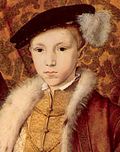 |
Edward VIb. 12 Oct 1537, London |
| Title: | Dei Gracia Anglie, Francie et Hibernie Rex, Fidei Defensor, et in terra ecclesie Anglicane et Hibernice supremum caput (By the Grace of God, King of England, France and Ireland, Defender of the Faith, and of the Church of England and also of Ireland in Earth Supreme Head) |
| Term: | 28 Jan 1547 - 6 Jul 1553 |
| Chronology: | 28 Jan 1547, succeeded his father, Henry VIII (proclamation of accession dated 31 Jan 1547; regnal years counted from 28 Jan 1547) |
| 20 Feb 1547, crowned, Westminster Abbey | |
| 6 Jul 1553, died |
| Biography: | |
Edward was the only son of King Henry VIII and his third wife Jane Seymour, who died 12 days after his birth. Edward was named heir apparent in the Act of Succession of 1544. After the death of Henry VIII (28 Jan 1547), the young prince acceded to the throne of England and was proclaimed on 31 Jan 1547. The sixteen executors nominated according to the last will of Henry VIII and the King's Privy Council turned out to be less powerful than the Edward's maternal uncle, Edward Seymour Earl of Hertford, who was appointed Protector (1 Feb 1547) and created Duke of Somerset (16 Feb 1547). In an attempt to force a marriage between Mary, Queen of Scots, and Edward VI, Somerset sent an army to Scotland. The English forces defeated the Scots in the Battle of Pinkie (10 Sep 1547), but the marriage never took place. Using the religious zeal of young Edward, Somerset proceeded with the Reformation acts imposing the first Book of Common Prayer and banning the Roman Catholic mass. In October 1549 the social and economic difficulties caused an uprising in Norfolk under the leadership of Robert Kett. The faction of the Earl of Warwick took advantage of this popular unrest to dismiss Somerset (8/10 Oct 1549) and to imprison him. Warwick became the most powerful member of the Council and was created Duke of Northumberland (11 Oct 1551). Somerset was executed on a trumped-up charge of felony (22 Jan 1552). Edward VI contracted tuberculosis and by May 1553 it was evident that the disease would be fatal. Northumberland used this opportunity to persuade Edward to change the order of succession prescribed by the acts of Henry VIII in favor of Lady Jane Grey, who was married to Northumberland's son, Guildford Dudley. On 21 Jun 1553 the fatally ill king signed "Letters Patent for the Limitation of the Crown", which excluded his half-sisters, Mary and Elizabeth, from the succession. Edward's death (6 Jul 1553) was not disclosed until 10 Jul 1553, when Jane was proclaimed queen in London. |
|
| | |
| [1] | Handbook of British Chronology (1986) |
| [2] | "England Under Protector Somerset", by A.F.Pollard (Russell & Russell Pub, 1966). |
| Image: portrait of King Edward VI by an unknown artist, c. 1546. | |
